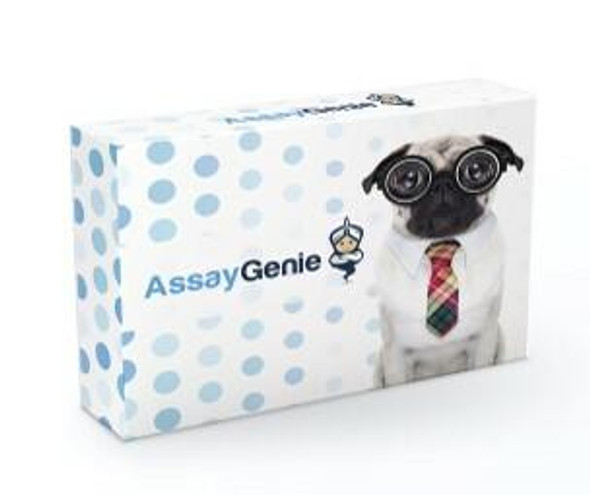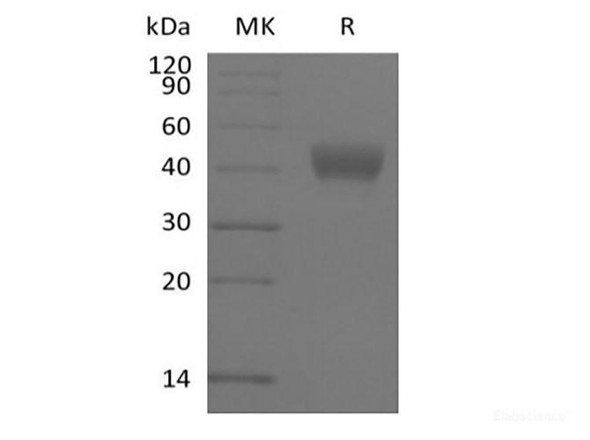Description
Rat ADP-ribosyl cyclase 1 (Cd38) ELISA Kit
The Rat ADP-Ribosyl Cyclase 1 (CD38) ELISA Kit is a highly sensitive and reliable tool for the accurate detection of CD38 levels in rat samples. This kit is designed for use with serum, plasma, and cell culture supernatants, providing researchers with a versatile solution for their studies.CD38 is an important enzyme involved in various biological processes, including calcium signaling, immune response modulation, and cellular adhesion. Dysregulation of CD38 has been linked to autoimmune diseases, inflammatory disorders, and cancer, highlighting the significance of this protein as a potential biomarker for disease diagnosis and treatment.
With its excellent performance characteristics, the Rat ADP-Ribosyl Cyclase 1 (CD38) ELISA Kit offers researchers a valuable tool for studying the role of CD38 in health and disease. Trust in the accuracy and precision of this kit to support your research goals and advance our understanding of CD38 biology.
| Product Name: | Rat ADP-ribosyl cyclase 1 (Cd38) ELISA Kit |
| SKU: | RTEB0437 |
| Size: | 96T |
| Target: | Rat ADP-ribosyl cyclase 1 (Cd38) |
| Synonyms: | 2'-phospho-ADP-ribosyl cyclase, 2'-phospho-ADP-ribosyl cyclase/2'-phospho-cyclic-ADP-ribose transferase, 2'-phospho-cyclic-ADP-ribose transferase, ADP-ribosyl cyclase 1, CD38H, Cyclic ADP-ribose hydrolase 1, ADPRC 1, cADPr hydrolase 1, CD38 |
| Assay Type: | Sandwich |
| Detection Method: | ELISA |
| Reactivity: | Rat |
| Detection Range: | 3.12-200ng/mL |
| Sensitivity: | 1.67ng/mL |
| Intra CV: | Provided with the Kit |
| Inter CV: | Provided with the Kit |
| Linearity: | Provided with the Kit |
| Recovery: | Provided with the Kit |
| Function: | Regulates osteoclastic bone resorption, probably via production of cyclic ADP-ribose and triggering of a cytosolic calcium ion signal through ryanodine receptor activation. |
| Uniprot: | Q64244 |
| Sample Type: | Serum, plasma, tissue homogenates, cell culture supernates and other biological fluids |
| Specificity: | Natural and recombinant rat ADP-ribosyl cyclase/cyclic ADP-ribose hydrolase 1 |
| Research Area: | Cancer |
| Subcellular Location: | Membrane Single-pass type II membrane protein |
| Storage: | Please see kit components below for exact storage details |
| Note: | For research use only |
| UniProt Protein Function: | CD38: Synthesizes cyclic ADP-ribose, a second messenger for glucose-induced insulin secretion. Also has cADPr hydrolase activity. Also moonlights as a receptor in cells of the immune system. Belongs to the ADP-ribosyl cyclase family. 2 isoforms of the human protein are produced by alternative splicing. |
| UniProt Protein Details: | Protein type:Hydrolase; Cell cycle regulation; Lyase; Membrane protein, integral; Cell surface; Apoptosis; EC 3.2.2.6; Cofactor and Vitamin Metabolism - nicotinate and nicotinamide; EC 2.4.99.20 Cellular Component: cell surface; membrane; intracellular membrane-bound organelle; plasma membrane; integral to membrane; nucleus Molecular Function:transferase activity; phosphorus-oxygen lyase activity; hydrolase activity, acting on glycosyl bonds; NAD+ nucleosidase activity; NAD(P)+ nucleosidase activity Biological Process: response to drug; response to retinoic acid; metabolic process; positive regulation of transcription, DNA-dependent; response to hormone stimulus; positive regulation of insulin secretion; female pregnancy; positive regulation of cell growth; response to estradiol stimulus; elevation of cytosolic calcium ion concentration; B cell receptor signaling pathway; response to hydroperoxide; response to cytokine stimulus; response to hypoxia; positive regulation of vasoconstriction; positive regulation of B cell proliferation; negative regulation of bone resorption; negative regulation of transcription, DNA-dependent; response to progesterone stimulus; negative regulation of apoptosis |
| NCBI Summary: | ADP-ribosyl cyclase enzyme involved in regulation of cellular calcium levels [RGD, Feb 2006] |
| UniProt Code: | Q64244 |
| NCBI GenInfo Identifier: | 6978629 |
| NCBI Gene ID: | 25668 |
| NCBI Accession: | NP_037259.1 |
| Molecular Weight: | 34,436 Da |
| NCBI Full Name: | ADP-ribosyl cyclase 1 |
| UniProt Protein Name: | ADP-ribosyl cyclase 1 |
| UniProt Synonym Protein Names: | CD38H; Cyclic ADP-ribose hydrolase 1 |
| Protein Family: | ADP-ribosyl cyclase/cyclic ADP-ribose hydrolase |
| UniProt Gene Name: | Cd38 |
| UniProt Entry Name: | CD38_RAT |
| Component | Quantity (96 Assays) | Storage |
| ELISA Microplate (Dismountable) | 8×12 strips | -20°C |
| Lyophilized Standard | 2 | -20°C |
| Sample Diluent | 20ml | -20°C |
| Assay Diluent A | 10mL | -20°C |
| Assay Diluent B | 10mL | -20°C |
| Detection Reagent A | 120µL | -20°C |
| Detection Reagent B | 120µL | -20°C |
| Wash Buffer | 30mL | 4°C |
| Substrate | 10mL | 4°C |
| Stop Solution | 10mL | 4°C |
| Plate Sealer | 5 | - |
Other materials and equipment required:
- Microplate reader with 450 nm wavelength filter
- Multichannel Pipette, Pipette, microcentrifuge tubes and disposable pipette tips
- Incubator
- Deionized or distilled water
- Absorbent paper
- Buffer resevoir
*Note: The below protocol is a sample protocol. Protocols are specific to each batch/lot. For the correct instructions please follow the protocol included in your kit.
Allow all reagents to reach room temperature (Please do not dissolve the reagents at 37°C directly). All the reagents should be mixed thoroughly by gently swirling before pipetting. Avoid foaming. Keep appropriate numbers of strips for 1 experiment and remove extra strips from microtiter plate. Removed strips should be resealed and stored at -20°C until the kits expiry date. Prepare all reagents, working standards and samples as directed in the previous sections. Please predict the concentration before assaying. If values for these are not within the range of the standard curve, users must determine the optimal sample dilutions for their experiments. We recommend running all samples in duplicate.
| Step | |
| 1. | Add Sample: Add 100µL of Standard, Blank, or Sample per well. The blank well is added with Sample diluent. Solutions are added to the bottom of micro ELISA plate well, avoid inside wall touching and foaming as possible. Mix it gently. Cover the plate with sealer we provided. Incubate for 120 minutes at 37°C. |
| 2. | Remove the liquid from each well, don't wash. Add 100µL of Detection Reagent A working solution to each well. Cover with the Plate sealer. Gently tap the plate to ensure thorough mixing. Incubate for 1 hour at 37°C. Note: if Detection Reagent A appears cloudy warm to room temperature until solution is uniform. |
| 3. | Aspirate each well and wash, repeating the process three times. Wash by filling each well with Wash Buffer (approximately 400µL) (a squirt bottle, multi-channel pipette,manifold dispenser or automated washer are needed). Complete removal of liquid at each step is essential. After the last wash, completely remove remaining Wash Buffer by aspirating or decanting. Invert the plate and pat it against thick clean absorbent paper. |
| 4. | Add 100µL of Detection Reagent B working solution to each well. Cover with the Plate sealer. Incubate for 60 minutes at 37°C. |
| 5. | Repeat the wash process for five times as conducted in step 3. |
| 6. | Add 90µL of Substrate Solution to each well. Cover with a new Plate sealer and incubate for 10-20 minutes at 37°C. Protect the plate from light. The reaction time can be shortened or extended according to the actual color change, but this should not exceed more than 30 minutes. When apparent gradient appears in standard wells, user should terminatethe reaction. |
| 7. | Add 50µL of Stop Solution to each well. If color change does not appear uniform, gently tap the plate to ensure thorough mixing. |
| 8. | Determine the optical density (OD value) of each well at once, using a micro-plate reader set to 450 nm. User should open the micro-plate reader in advance, preheat the instrument, and set the testing parameters. |
| 9. | After experiment, store all reagents according to the specified storage temperature respectively until their expiry. |
When carrying out an ELISA assay it is important to prepare your samples in order to achieve the best possible results. Below we have a list of procedures for the preparation of samples for different sample types.
| Sample Type | Protocol |
| Serum | If using serum separator tubes, allow samples to clot for 30 minutes at room temperature. Centrifuge for 10 minutes at 1,000x g. Collect the serum fraction and assay promptly or aliquot and store the samples at -80°C. Avoid multiple freeze-thaw cycles. If serum separator tubes are not being used, allow samples to clot overnight at 2-8°C. Centrifuge for 10 minutes at 1,000x g. Remove serum and assay promptly or aliquot and store the samples at -80°C. Avoid multiple freeze-thaw cycles. |
| Plasma | Collect plasma using EDTA or heparin as an anticoagulant. Centrifuge samples at 4°C for 15 mins at 1000 × g within 30 mins of collection. Collect the plasma fraction and assay promptly or aliquot and store the samples at -80°C. Avoid multiple freeze-thaw cycles. Note: Over haemolysed samples are not suitable for use with this kit. |
| Urine & Cerebrospinal Fluid | Collect the urine (mid-stream) in a sterile container, centrifuge for 20 mins at 2000-3000 rpm. Remove supernatant and assay immediately. If any precipitation is detected, repeat the centrifugation step. A similar protocol can be used for cerebrospinal fluid. |
| Cell culture supernatant | Collect the cell culture media by pipette, followed by centrifugation at 4°C for 20 mins at 1500 rpm. Collect the clear supernatant and assay immediately. |
| Cell lysates | Solubilize cells in lysis buffer and allow to sit on ice for 30 minutes. Centrifuge tubes at 14,000 x g for 5 minutes to remove insoluble material. Aliquot the supernatant into a new tube and discard the remaining whole cell extract. Quantify total protein concentration using a total protein assay. Assay immediately or aliquot and store at ≤ -20 °C. |
| Tissue homogenates | The preparation of tissue homogenates will vary depending upon tissue type. Rinse tissue with 1X PBS to remove excess blood & homogenize in 20ml of 1X PBS (including protease inhibitors) and store overnight at ≤ -20°C. Two freeze-thaw cycles are required to break the cell membranes. To further disrupt the cell membranes you can sonicate the samples. Centrifuge homogenates for 5 mins at 5000xg. Remove the supernatant and assay immediately or aliquot and store at -20°C or -80°C. |
| Tissue lysates | Rinse tissue with PBS, cut into 1-2 mm pieces, and homogenize with a tissue homogenizer in PBS. Add an equal volume of RIPA buffer containing protease inhibitors and lyse tissues at room temperature for 30 minutes with gentle agitation. Centrifuge to remove debris. Quantify total protein concentration using a total protein assay. Assay immediately or aliquot and store at ≤ -20 °C. |
| Breast Milk | Collect milk samples and centrifuge at 10,000 x g for 60 min at 4°C. Aliquot the supernatant and assay. For long term use, store samples at -80°C. Minimize freeze/thaw cycles. |









